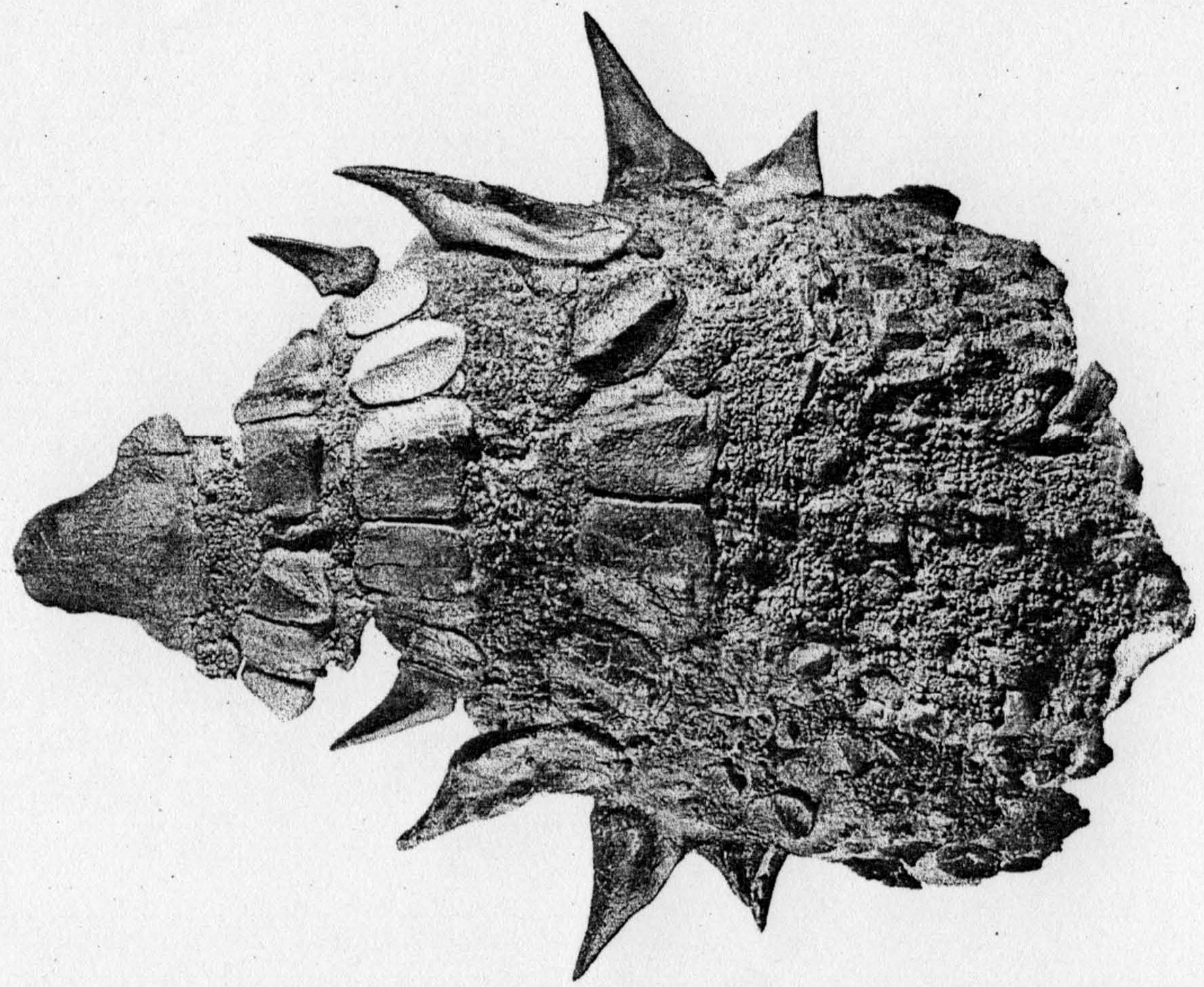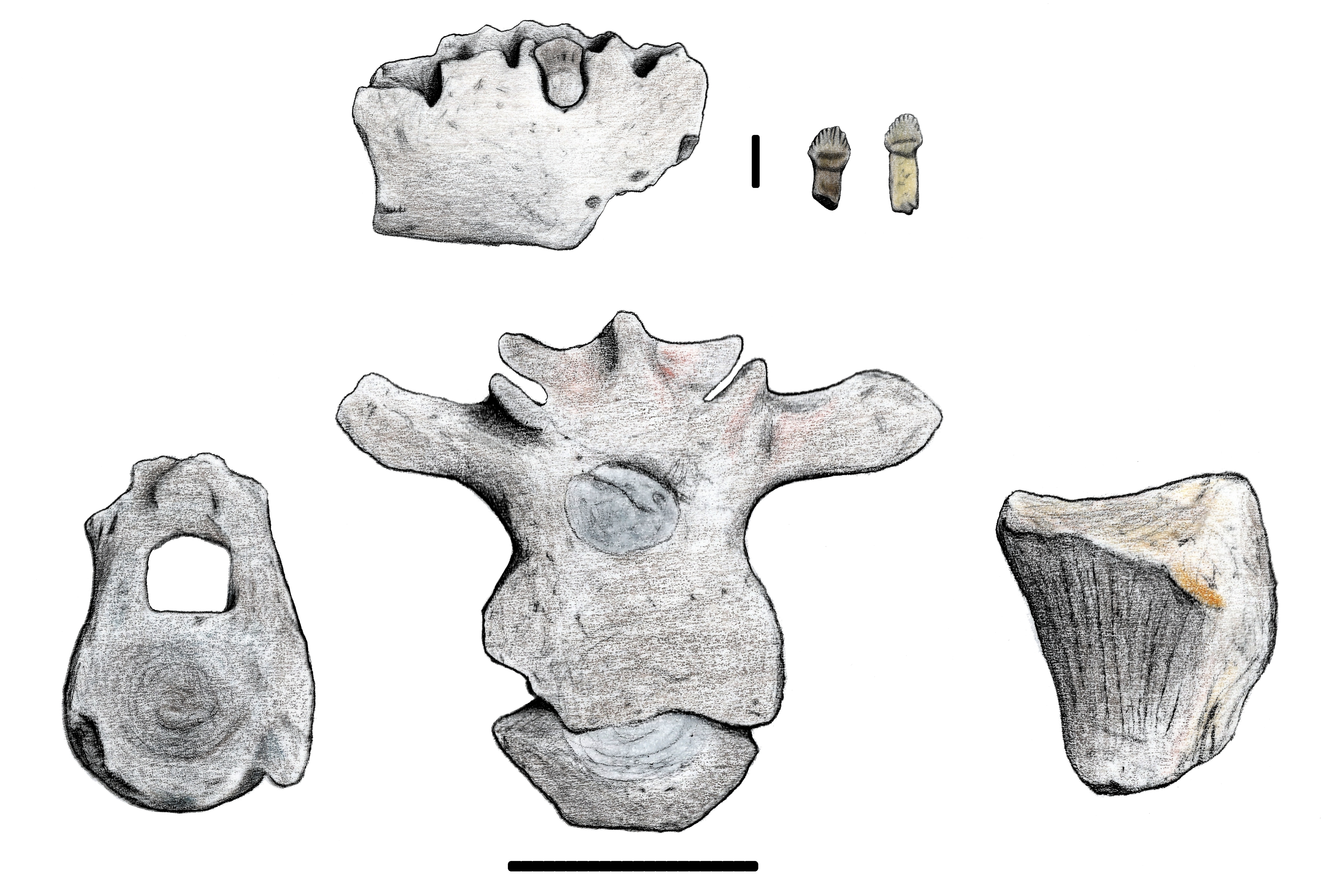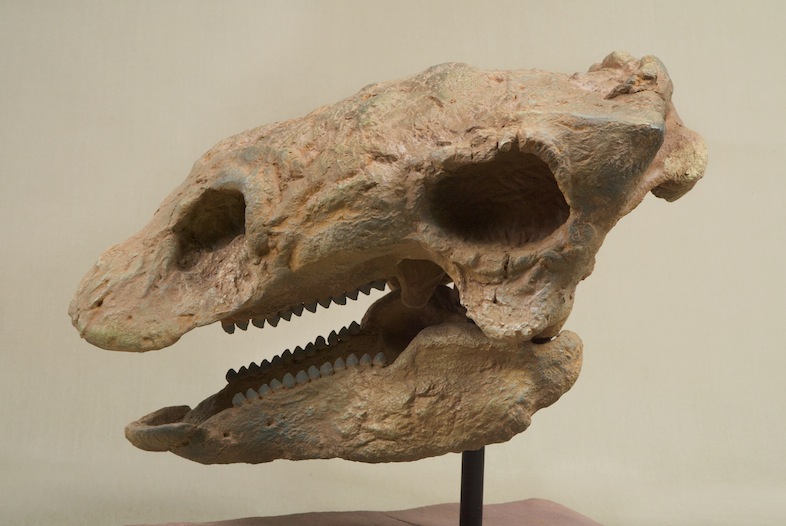|
Ankylosauria
Ankylosauria is a group of herbivorous dinosaurs of the order Ornithischia. It includes the great majority of dinosaurs with armor in the form of bony osteoderms, similar to turtles. Ankylosaurs were bulky quadrupeds, with short, powerful limbs. They are known to have first appeared in the Middle Jurassic, and persisted until the end of the Cretaceous Period. The two main families of Ankylosaurs, Nodosauridae and Ankylosauridae are primarily known from the Northern Hemisphere, but the more basal Parankylosauria are known from southern Gondwana during the Cretaceous. Ankylosauria was first named by Henry Fairfield Osborn in 1923.Osborn, H. F. (1923). "Two Lower Cretaceous dinosaurs of Mongolia." ''American Museum Novitates'', 95: 1–1/ref> In the Linnaean classification system, the group is usually considered either a suborder or an infraorder. It is contained within the group Thyreophora, which also includes the stegosaurs, armored dinosaurs known for their combination of plate ... [...More Info...] [...Related Items...] OR: [Wikipedia] [Google] [Baidu] |
Parankylosauria
Parankylosauria is a group of basal ankylosaurian dinosaurs known from the Cretaceous of South America, Antarctica, and Australia. It is thought the group split from other ankylosaurs during the mid-Jurassic period, despite this being unpreserved in the fossil record. History of research During the Mesozoic era, the southern continents (South America, Antarctica, Australia, and Africa in addition to India and Zealandia) were unified into a supercontinent known as Gondwana. This was in contrast to the supercontinent of Laurasia in the Northern Hemisphere, with both originating from the breakup of Pangaea. Gondwana itself gradually split apart over the course of the Jurassic and Cretaceous eras. Ankylosaurian dinosaurs from Laurasia have historically been far more extensively recorded and studied. Reports of the group in Gondwana date back to 1904, with a specimen from Australia and include referrals of ''Loricosaurus'', ''Lametasaurus'', and ''Brachypodosaurus'' to group among ass ... [...More Info...] [...Related Items...] OR: [Wikipedia] [Google] [Baidu] |
Dinosaur
Dinosaurs are a diverse group of reptiles of the clade Dinosauria. They first appeared during the Triassic period, between 243 and 233.23 million years ago (mya), although the exact origin and timing of the evolution of dinosaurs is the subject of active research. They became the dominant terrestrial vertebrates after the Triassic–Jurassic extinction event 201.3 mya; their dominance continued throughout the Jurassic and Cretaceous periods. The fossil record shows that birds are feathered dinosaurs, having evolved from earlier theropods during the Late Jurassic epoch, and are the only dinosaur lineage known to have survived the Cretaceous–Paleogene extinction event approximately 66 mya. Dinosaurs can therefore be divided into avian dinosaurs—birds—and the extinct non-avian dinosaurs, which are all dinosaurs other than birds. Dinosaurs are varied from taxonomic, morphological and ecological standpoints. Birds, at over 10,700 living species, are among ... [...More Info...] [...Related Items...] OR: [Wikipedia] [Google] [Baidu] |
Mymoorapelta
''Mymoorapelta'' (Meaning "Vannetta Moore and Pete and Marilyn Mygatt's shield" after a combination of the names of the discoverers of the Mygatt-Moore Quarry that fossils were originally collected from, and pɛltə "shield") is a monospecific genus of nodosaurid ankylosaur, a group of heavily armored, herbivorous, quadrupedal dinosaurs, from the Late Jurassic (Kimmeridgian- Tithonian, around 155 to 150 million years ago) Morrison Formation (Brushy Basin Member) of western Colorado and central Utah, USA. Few specimens are known, but the most complete one is the holotype individual from the Mygatt-Moore Quarry that includes many osteoderms, a partial skull, vertebrae, and other bones. It was initially described by James Kirkland and Kenneth Carpenter in 1994. Along with ''Gargoyleosaurus'', it is one of the earliest known nodosaurids. ''Mymoorapleta'' is one of the smaller known nodosaurids, with the estimated length of the largest specimen only reaching . It had a narrow snou ... [...More Info...] [...Related Items...] OR: [Wikipedia] [Google] [Baidu] |
Nodosauridae
Nodosauridae is a family of ankylosaurian dinosaurs, from the Late Jurassic to the Late Cretaceous period in what is now North America, South America, Europe, and Asia. Description Nodosaurids, like their close relatives the ankylosaurids, were heavily armored dinosaurs adorned with rows of bony armor nodules and spines (osteoderms), which were covered in keratin sheaths. All nodosaurids, like other ankylosaurians, were medium-sized to large, heavily built, quadrupedal, herbivorous dinosaurs, possessing small, leaf-shaped teeth. Unlike ankylosaurids, nodosaurids lacked mace-like tail clubs, instead having flexible tail tips. Many nodosaurids had spikes projecting outward from their shoulders. One particularly well-preserved nodosaurid "mummy", known as the Suncor nodosaur (''Borealopelta markmitchelli''), preserved a nearly complete set of armor in life position, as well as the keratin covering and mineralized remains of the underlying skin, which indicate reddish dorsal pigmen ... [...More Info...] [...Related Items...] OR: [Wikipedia] [Google] [Baidu] |
Liaoningosaurus
''Liaoningosaurus'' is an unusual genus of ankylosaurian dinosaurs from the Early Cretaceous period of China. It contains a single species, ''Liaoningosaurus paradoxus'', and is represented by two fossil specimens collected from the Yixian Formation (Aptian age) of Liaoning. ''L. paradoxus'' was unusual among advanced ornithischian dinosaurs in that it is speculated to have hunted or scavenged, with preserved gut contents showing that it may have eaten fish. Additionally, some features of its skeleton may suggest that it was partially aquatic.Ji Q., Wu X., Cheng Y., Ten F., Wang X., and Ji Y. 2016Fish-hunting ankylosaurs (Dinosauria, Ornithischia) from the Cretaceous of China ''Journal of Geology'', 40(2) . The type species ''L. paradoxus'' was named in 2001. The generic name refers to Liaoning. The specific name refers to the confusing mix of nodosaurid and ankylosaurid features shown by the specimen. Discovery The holotype IVPP V12560 is an articulated skeleton measuring ... [...More Info...] [...Related Items...] OR: [Wikipedia] [Google] [Baidu] |
Borealopelta
''Borealopelta'' (meaning "Northern shield") is a genus of nodosaurid ankylosaur from the Lower Cretaceous of Alberta, Canada. It contains a single species, ''B. markmitchelli'', named in 2017 by Caleb Brown and colleagues from a well-preserved specimen known as the Suncor nodosaur. Discovered at an oil sands mine north of Fort McMurray, Alberta, the specimen is remarkable for being among the best-preserved dinosaur fossils of its size ever found. It preserved not only the armor (''osteoderms'') in their life positions, but also remains of their keratin sheaths, overlying skin, and stomach contents from the animal's last meal. Melanosomes were also found that indicate the animal had a reddish skin tone. Discovery and history The holotype specimen was uncovered on March 21, 2011, at the Millennium Mine, an oil sands mine north of Fort McMurray, Alberta, that is owned and operated by Suncor Energy. It was discovered by a miner, Shawn Funk, who was digging in the bank and notice ... [...More Info...] [...Related Items...] OR: [Wikipedia] [Google] [Baidu] |
Spicomellus
''Spicomellus'' (meaning "collar of spikes") is an extinct genus of herbivorous ankylosaurian dinosaur that lived in the supercontinent Gondwana during the Middle Jurassic Period. The type and only known species is ''Spicomellus afer'', named and described in 2021. Its remains were found in the third subunit of the El Mers Group (Bathonian-Callovian), near Boulahfa, south of Boulemane, Fès-Meknès, Morocco. The genus name means "spiked collar", from the Latin 'spica' meaning spike, and 'mellum' meaning spiked dog collar and the specific name 'afer' means "the African". During the Jurassic, eurypodan dinosaurs, in particular stegosaurs, were diverse and abundant in Laurasia (nowadays the northern continents), but their remains are extremely rare in Gondwanan deposits, nowadays the southern continents. Nevertheless, the existence of fragmentary remains and trackways in the deposits of Gondwana indicates the presence of eurypodan taxa there. ''Spicomellus'' is the second des ... [...More Info...] [...Related Items...] OR: [Wikipedia] [Google] [Baidu] |
Tianzhenosaurus
''Tianzhenosaurus'' (meaning “ Tianzhen lizard”) is a monospecific genus of ankylosaurid dinosaur from the Shanxi Province that lived during the Late Cretaceous (Cenomanian-Campanian, ~99-71 Ma) in what is now the Huiquanpu Formation. ''Tianzhenosaurus'' may represent a junior synonym of ''Saichania'', an ankylosaurine known from the Barun Goyot and Nemegt Formation. Discovery and naming In 1983, Pang Qiqing and Cheng Zhengwu discovered articulated cervical vertebrae of an ankylosaurid from the Shanxi Province. Numerous excavations at the site yielded more than 2,300 specimens belonging to sauropods, theropods, ornithopods and ankylosaurid specimens. The holotype specimen, HBV-10001, consists of a partial skull. Two paratype specimens were assigned to ''Tianzhenosaurus'': HBV-10002, an incomplete mandible; HBV-10003, cervical vertebrae, dorsal vertebrae, caudal vertebrae, a sacral complex, ilia, pectoral girdles, pelvic girdles, fore and hind limbs with fore and hind feet, ta ... [...More Info...] [...Related Items...] OR: [Wikipedia] [Google] [Baidu] |
Sarcolestes
''Sarcolestes'' (meaning "flesh robber") is an extinct genus of ankylosaurian ornithischian dinosaur from the Oxford Clay of England. The current type and only species is ''S. leedsi'', and the holotype is a single partial left mandible. The genus and species were named in 1893 by Richard Lydekker, who thought they belonged to a theropod. Discovery ''Sarcolestes'' was first named in 1893 by Richard Lydekker, and its type species was designated as ''S. leedsi''. The specific name was to honour Alfred Nicholson Leeds, the discoverer of the specimen, and many others like it. The holotype and only specimen, is a partial left mandible and fused scute that was damaged during excavation. The jaw preserved one entire tooth and two crown tips in its alveolus, with the missing bone in the central section of the mandible. It lacks a preserved predentary, even though the entire mandibular symphysis is preserved and complete. Classification Originally, Lydekker found that ''Sarcolestes'' ... [...More Info...] [...Related Items...] OR: [Wikipedia] [Google] [Baidu] |
Edmontonia
''Edmontonia'' is a genus of panoplosaurin nodosaurid dinosaur from the Late Cretaceous Period. It is part of the Nodosauridae, a family within Ankylosauria. It is named after the Edmonton Formation (now the Horseshoe Canyon Formation in Canada), the unit of rock where it was found. Description Size and general build ''Edmontonia'' was bulky, broad and tank-like. Its length has been estimated at about 6.6 m (22 ft). In 2010, Gregory S. Paul considered both main ''Edmontonia'' species, ''E. longiceps'' and ''E. rugosidens'', to be equally long at six metres and weigh three tonnes.Paul, G.S., 2010, ''The Princeton Field Guide to Dinosaurs'', Princeton University Press p. 238 ''Edmontonia'' had small, oval ridged bony plates on its back and head and many sharp spikes along its sides. The four largest spikes jutted out from the shoulders on each side, the second of which was split into subspines in ''E. rugosidens'' specimens. Its skull had a pear-like shape when viewed ... [...More Info...] [...Related Items...] OR: [Wikipedia] [Google] [Baidu] |
Gastonia (dinosaur)
''Gastonia'' is a genus of herbivorous ankylosaurian dinosaur from the Early Cretaceous of North America, around 139 to 125 million years ago. It is often considered a nodosaurid closely related to ''Polacanthus''. ''Gastonia'' has a sacral shield and large shoulder spikes. Discovery and species The type specimen of ''Gastonia burgei'' ( CEUM 1307) was discovered in a bonebed from the limestone strata of the lower Cedar Mountain Formation in Yellow Cat Quarry, Grand County, eastern Utah, the type specimen consisting of a single skull. The type specimen was found alongside 4 partial skeletons of ''Gastonia that'' were placed as paratypes, along with the type specimen of ''Utahraptor'' and an Iguanodontid. ''Gastonia'' is among the most common dinosaur fossils in the Cedar Mountain Formation, with many individuals being found across several quarries in the southwest.Kirkland, J.I. (1998). A polacanthine ankylosaur (Ornithischia: Dinosauria) from the Early Cretaceous (Barremian) o ... [...More Info...] [...Related Items...] OR: [Wikipedia] [Google] [Baidu] |
Denversaurus
''Denversaurus'' (meaning "Denver lizard") is a genus of panoplosaurin nodosaurid dinosaur from the Late Cretaceous (late Maastrichtian) of western North America. Although at one point treated as a junior synonym of ''Edmontonia'' by some taxonomists, current research indicates that it is a distinct nodosaurid genus. Discovery and naming In 1922, Philip Reinheimer, a collector and technician employed by the Colorado Museum of Natural History, the predecessor of the present Denver Museum of Nature and Science, near the Twito Ranch in Corson County, South Dakota discovered the fossil of an ankylosaurian in a Maastrichtian age terrestrial horizon of the Lance Formation. In 1943, American paleontologist Barnum Brown referred the find to ''Edmontonia longiceps''. In 1988, Robert Thomas Bakker decided to split the genus ''Edmontonia''. The species ''Edmontonia rugosidens'' he made into a separate genus ''Chassternbergia'' and the Denver fossil was named and described as a new genu ... [...More Info...] [...Related Items...] OR: [Wikipedia] [Google] [Baidu] |









